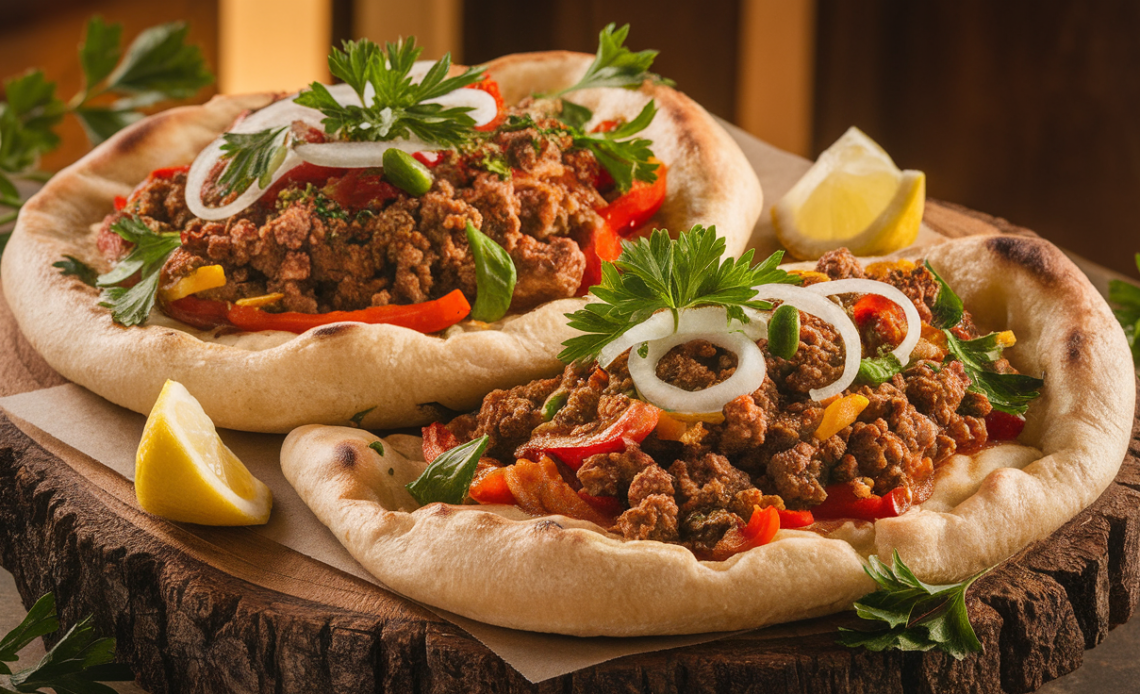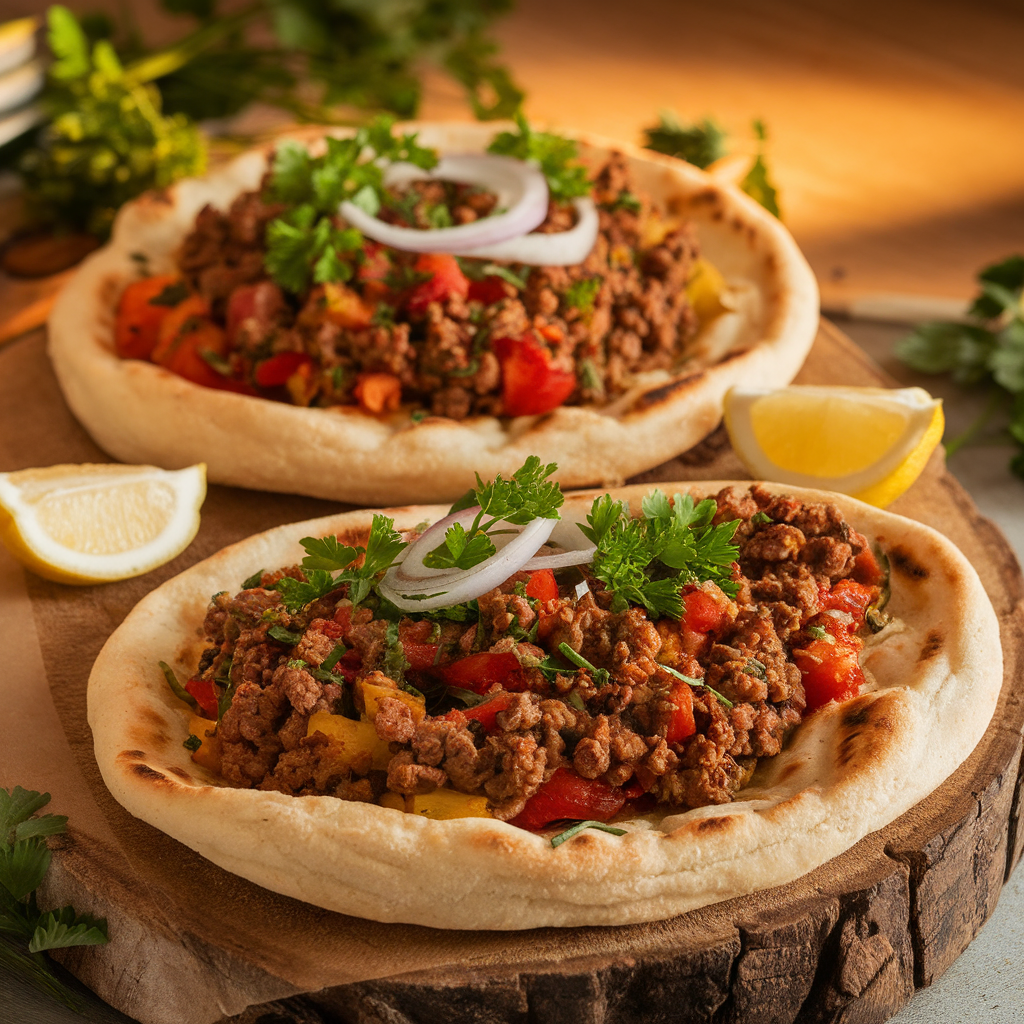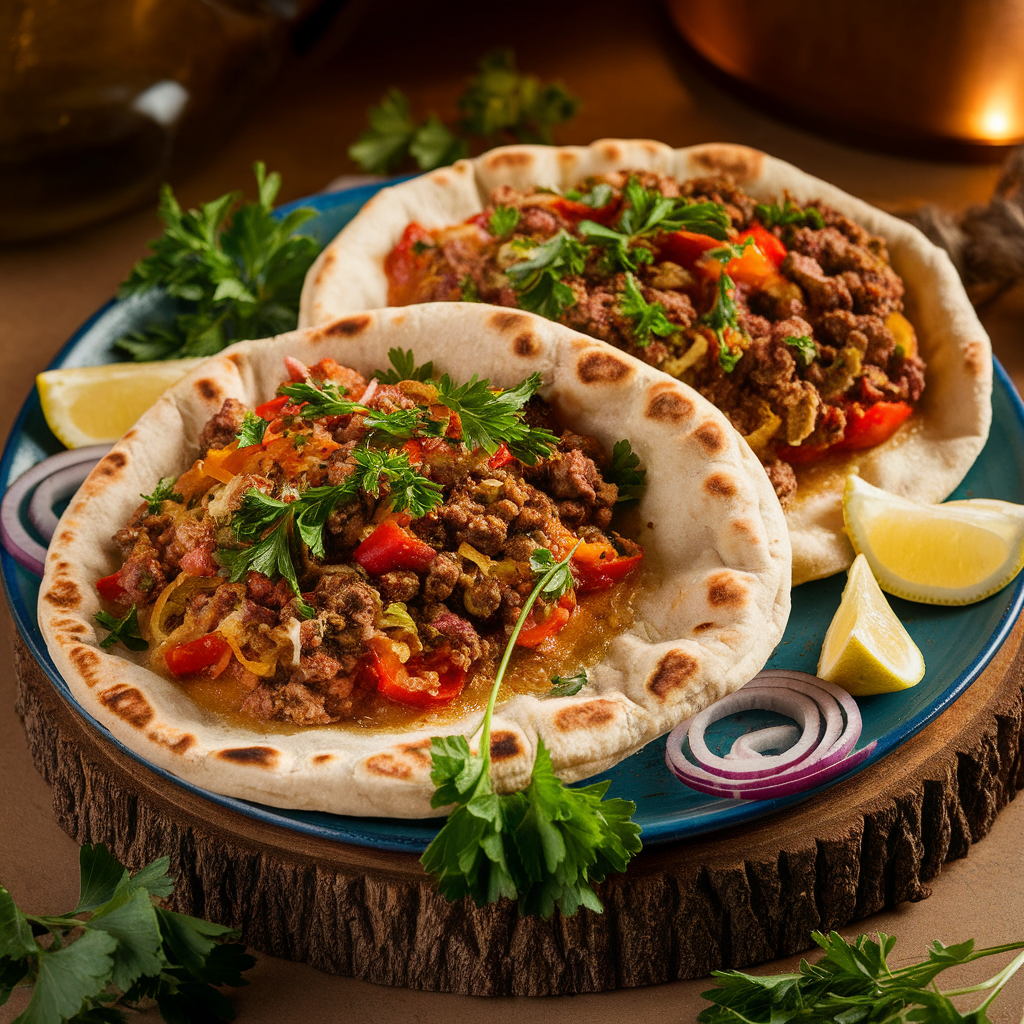
If you’re a fan of foreign food recipes that blend rich history, bold spices, and satisfying textures, then you’re about to discover your next favorite dish: Lahmacun. Often called “Turkish Pizza” or sometimes referred to as an Arabic pizza recipe, Lahmacun (pronounced: Lah-mah-june) is a beloved street food and traditional meal that dates back centuries, making it an iconic staple in the world of Turkish meals and medieval cooking. This dish offers the best of grounded meat recipes, wrapped in an irresistible crispy flatbread.
In this extensive guide, we’ll explore the origins of Lahmacun, why it’s considered one of the best meat meals, and how to prepare the perfect homemade Lahmacun recipe from scratch—including dough, meat topping, baking instructions, serving ideas, and even modern twists.
📜 What is Lahmacun?
Lahmacun is a traditional Turkish recipe made from a thin, round flatbread topped with a spiced mixture of ground meat (usually lamb or beef), fresh herbs, vegetables, and savory Middle Eastern seasonings. Unlike Western-style pizza, Lahmacun contains no cheese or tomato sauce. Instead, it highlights the bold flavors of cumin, paprika, garlic, onion, and parsley—all spread over a whisper-thin crust that gets baked until golden and crisp.
It’s folded, rolled, or simply eaten flat, often served with fresh lemon juice, sumac onions, parsley, and even a crunchy salad on the side. This meat meal is ideal for lunch, dinner, or as part of a mezze spread.
🏺 A Glimpse Into History: Lahmacun and Medieval Cooking
Lahmacun’s roots trace back to the Levant and Mesopotamian civilizations. It shares ancestry with flatbread dishes that were common in medieval cooking, particularly across the Arab world, Persia, and Anatolia. Lahmacun gained its current form in Turkey during the Ottoman Empire and has since become a treasured street food across the Middle East, especially in Turkey, Syria, Lebanon, and Armenia.
The name Lahmacun comes from the Arabic “lahm bi-‘ajin” (لحم بعجين), which literally means “meat with dough”. This linguistic connection reinforces its classification as a prominent Arabic pizza recipe.
🛒 Ingredients – Everything You’ll Need
Making authentic Lahmacun at home requires two components: the dough and the spiced ground meat topping. Here’s a breakdown of what you’ll need.

For the Dough:
- 3 cups all-purpose flour
- 1 tsp salt
- 1 tsp sugar
- 1 tsp instant yeast
- 2 tbsp olive oil
- 1 cup warm water (add more as needed)
For the Meat Topping:
- 300g ground lamb (or ground beef for a milder flavor)
- 1 small onion, finely grated or minced
- 1 medium tomato, grated
- 2 cloves garlic, minced
- 1/2 red bell pepper, finely chopped
- 1 tbsp tomato paste
- 1 tbsp pepper paste (or additional tomato paste if unavailable)
- 2 tbsp chopped flat-leaf parsley
- 1 tsp cumin
- 1 tsp sweet paprika
- 1/2 tsp cayenne pepper (optional for heat)
- 1/2 tsp ground cinnamon (for depth)
- Salt and pepper to taste
- 1 tbsp olive oil
- Juice of half a lemon
Optional Garnishes:
- Fresh parsley leaves
- Sliced red onions with sumac
- Lemon wedges
- Pickled vegetables
- Lettuce, tomato, cucumber (for wrapping)
🧑🍳 How to Make Lahmacun at Home
Let’s dive into the full process of preparing this Turkish recipe—from kneading dough to creating the savory topping and serving it like they do in Istanbul.
Step 1: Prepare the Dough
- Mix the Dry Ingredients: In a large mixing bowl, combine the flour, salt, sugar, and instant yeast.
- Add the Wet Ingredients: Slowly pour in the warm water and olive oil, mixing with a spoon or your hands until a shaggy dough forms.
- Knead: Transfer to a lightly floured surface and knead for 8–10 minutes until the dough becomes smooth and elastic.
- Rest the Dough: Place the dough in a lightly oiled bowl, cover with a damp towel or plastic wrap, and let it rise in a warm spot for 1 hour or until doubled in size.

Step 2: Make the Ground Meat Topping
This is where the Lahmacun shines as one of the most flavorful grounded meat recipes.
- Combine Ingredients: In a large bowl, mix the ground meat with onion, tomato, garlic, red pepper, tomato and pepper paste, parsley, and all the spices.
- Add Oil and Lemon: Drizzle in the olive oil and squeeze in the lemon juice. Stir thoroughly to create a smooth, spreadable mixture.
- Chill (Optional): For deeper flavor, let the mixture rest in the fridge for 30 minutes. This also makes it easier to spread onto the dough.
Step 3: Shape and Assemble the Lahmacun
- Preheat the Oven: Set your oven to its highest setting—ideally 475–500°F (245–260°C). If you have a pizza stone or steel, place it inside to preheat.
- Divide the Dough: Punch down the risen dough and divide into 6–8 equal balls. Roll each ball into a thin circle (about 10–12 inches) on a lightly floured surface.
- Spread the Meat Mixture: Using a spoon or your fingers, spread a thin, even layer of the meat topping over the surface of each dough round. Press gently to adhere.
Step 4: Bake the Lahmacun
- Transfer to Baking Surface: Carefully place each prepared Lahmacun on a parchment-lined baking sheet or directly onto the hot stone/steel.
- Bake: Cook for 6–8 minutes or until the edges are crisp, the bottom is golden, and the meat is fully cooked. Watch closely to avoid burning.
- Cool Slightly: Remove from the oven and cool on a wire rack for 1–2 minutes before serving.
🥗 How to Serve Lahmacun
Traditionally, Lahmacun is served fresh from the oven, folded or rolled with a squeeze of lemon and a handful of greens. Here are some classic accompaniments:
- A mix of parsley and onions tossed with sumac
- Lemon wedges for drizzling
- A side of pickled turnips or cucumbers
- Ayran (a cold yogurt drink) to complement the spices
- Salad of chopped lettuce, tomatoes, and cucumbers for wrapping
Lahmacun is often enjoyed like a wrap: place the garnishes on top, fold or roll, and take a satisfying bite.
🍴 Tips for Perfect Lahmacun
- Use Quality Meat: The flavor of Lahmacun depends heavily on the meat quality. Opt for freshly ground lamb or beef with a bit of fat for juiciness.
- Don’t Overload the Dough: A thin layer of topping ensures even cooking and crispiness.
- Get the Oven Hot: A blisteringly hot oven mimics the traditional clay ovens used in Turkish bakeries.
- Freeze for Later: You can freeze the uncooked, topped dough between parchment paper for future meals.
🥩 Variations and Modern Twists
While Lahmacun is a classic, it also lends itself to modern adaptations:
- Vegan Lahmacun: Replace meat with a mix of cooked lentils, mushrooms, and walnuts.
- Cheesy Lahmacun: Add a sprinkle of shredded mozzarella or feta before baking (non-traditional, but delicious).
- Mini Lahmacuns: Perfect for parties and appetizers—make them bite-sized!
- Grilled Lahmacun: Cook directly on a BBQ grill for a smoky finish.

🌍 Why You’ll Love Lahmacun
Whether you’re exploring Turkish meals for the first time or looking to expand your foreign food recipes collection, Lahmacun offers a perfect balance of simplicity, spice, and cultural richness. It embodies everything great about grounded meat recipes—flavorful, filling, and versatile.
For lovers of medieval cooking and food anthropology, Lahmacun connects you with centuries of culinary evolution, from the bustling markets of ancient Aleppo to the modern kitchens of Istanbul and beyond.
It’s an ideal weeknight dinner, a showstopping addition to a Middle Eastern feast, or a unique alternative to pizza night. Best of all, you can make it completely from scratch in your own kitchen.
🧾 Nutritional Info (Per Lahmacun – Approximate)
- Calories: 350–400
- Protein: 18g
- Carbohydrates: 35g
- Fat: 18g
- Fiber: 2g
- Sugar: 3g
📌 Final Thoughts
If you’ve been looking for a unique meat meal that’s packed with heritage and flavor, Lahmacun is the answer. This Lahmacun recipe will bring the magic of Turkish street food to your table, with bold spices, crispy dough, and a satisfying meat topping that’s hard to resist.
Whether you’re cooking for family or entertaining guests, Lahmacun is the perfect fusion of ancient flavor and modern comfort. So next time you want to make something special, skip the regular pizza—and make Lahmucan instead.




